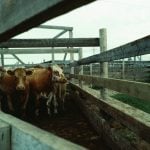
Scours

Shifting to the Sandhills calving system to cut scours in young beef calves
While it’s not for every operation, the Sandhills calving system can reduce diarrhea in young calves
Cow-calf producers across North America face wide-ranging challenges each calving season but scours and neonatal diarrhea often top the list. Various systems are used to help prevent what can become devastating losses when these pathogens gain a foothold. An established approach still growing in popularity is the Sandhills calving system, designed to separate newborns and […] Read more

Surviving scours
Prevention is the best medicine, but when you’re in the middle of an outbreak, it’s all about getting through it
Scours. It should be a four-lettered word, for all the misery it causes on cow-calf operations. Even with the best preventative practices, outbreaks can pop up in herds. And in the middle of an outbreak, the focus is on survival, for calves and humans alike. During an outbreak, producers are generally going to see a […] Read more

AUDIO: Dealing with a scours outbreak in cattle
Scours is always an unwelcome guest during calving season, and one that can visit even the best-managed herds. In this interview, Dr. Claire Windeyer of the University of Calgary’s faculty of veterinary medicine, discusses how to manage an outbreak, protecting calves and people alike from this disease and how a bit of record keeping can […] Read more

One Health strategies help farm family navigate outbreak
The Haraga family calls in the troops to deal with a nasty zoonotic disease
This article was originally published at beefresearch.ca. It is reprinted here with the permission of the Beef Cattle Research Council. For Tyler and Nancy Haraga, March 10, 2018, will forever stand out in their minds. “It was forty below with four to five feet of snow,” says Tyler. It had been a brutal winter, with […] Read more

Fighting mud at calving season
Vet Advice with Dr. Ron Clarke
Muddy corrals in early spring are unacceptable for calving. Mud can be a sign of neglect or the unfortunate result of late spring snow storms severe enough to backfill crowded corrals to the point calves are trampled and smothered, or forced to live in the squalor of mud, cold and discomfort. Mud, if not managed […] Read more

Introducing outside calves heightens crypto risk
Cryptosporidium parvum is a disease that’s easy to introduce and hard to manage in a beef herd
In the cold, wet pastures of a gruelling Manitoba spring near Oakville, Man., Garth McCormick needed a calf to put on one of his cows who had lost her calf, but didn’t have any he could use on his own farm. His hired man brought a calf from his own place to McCormick’s. Immediately, the […] Read more

Calf 911: Managing colostrum so newborn calves thrive
Ensuring newborn calves consume colostrum is one of the most important management strategies cow-calf operations can implement to promote healthy calves. Colostrum provides essential antibodies (such as immunoglobulin G or IgG) to a calf with virtually no immune system. Colostrum also contains fats, vitamins, proteins and other immune cells essential to provide the calf energy, […] Read more

Calf 911: How to spot dehydration in young or scouring calves
It’s a great feeling when a calf arrives on the ground safe and sound. Ideally, things go well, and cows and newborn calves thrive. However, it’s important for producers to take the time to look for signs of early illness in neonatal calves. Being able to recognize the symptoms of disease and dehydration in baby […] Read more

A tale of two calving systems
Confined and pasture methods each have risks and benefits
For beef producers, calving season can be both stressful and enjoyable. Witnessing new life can be refreshing, but calving time is the most critical period in the cow-calf production cycle. Whether or not calving season is a success will set the tone for an operations’ entire year or longer, having an impact on animal health, […] Read more

Scours in calves
Scours is a common illness in young calves. Understand the causes and effects of this disease to treat and prevent it
Scours can be caused by certain kinds of bacteria, viruses or protozoa, but other factors come into play as well. “It’s often the interaction between the immune system, the environment and the pathogen load. The old saying is that the solution to pollution is dilution (or) minimizing the pathogen load,” says Dr. Paul Hardes, a […] Read more



